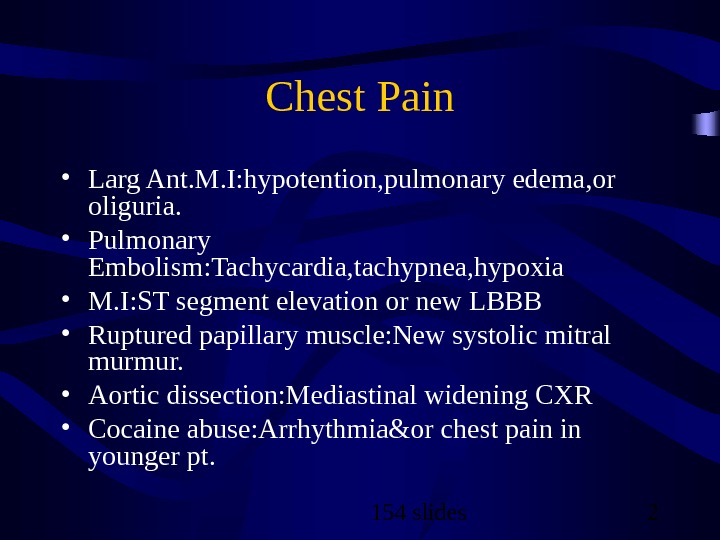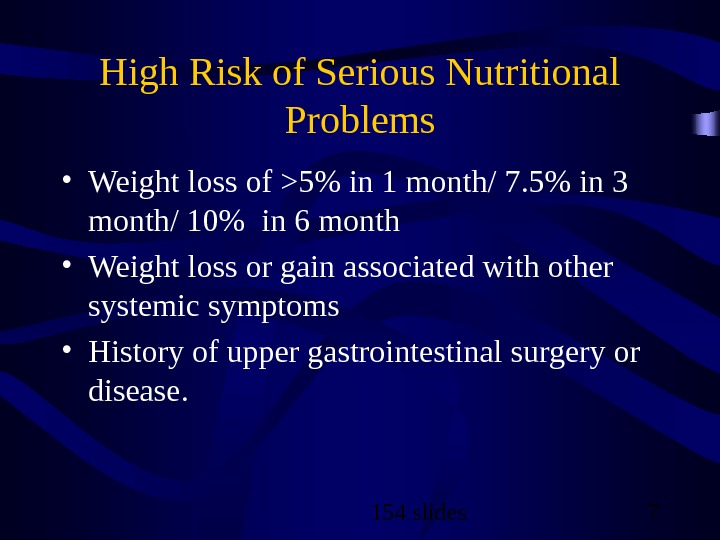RED FLAGS 154 slides 2 Chest Pain
























- Размер: 82.5 Кб
- Количество слайдов: 23
Описание презентации RED FLAGS 154 slides 2 Chest Pain по слайдам
 RED FLAGS
RED FLAGS
 154 slides 2 Chest Pain • Larg Ant. M. I: hypotention, pulmonary edema, or oliguria. • Pulmonary Embolism: Tachycardia, tachypnea, hypoxia • M. I: ST segment elevation or new LBBB • Ruptured papillary muscle: New systolic mitral murmur. • Aortic dissection: Mediastinal widening CXR • Cocaine abuse: Arrhythmia&or chest pain in younger pt.
154 slides 2 Chest Pain • Larg Ant. M. I: hypotention, pulmonary edema, or oliguria. • Pulmonary Embolism: Tachycardia, tachypnea, hypoxia • M. I: ST segment elevation or new LBBB • Ruptured papillary muscle: New systolic mitral murmur. • Aortic dissection: Mediastinal widening CXR • Cocaine abuse: Arrhythmia&or chest pain in younger pt.
 154 slides 3 DVT • Dyspnea, tachypnea • Chest pain • Syncope • Hypotension, pulmonary edema, cyanosis • Fever
154 slides 3 DVT • Dyspnea, tachypnea • Chest pain • Syncope • Hypotension, pulmonary edema, cyanosis • Fever
 154 slides 4 DM hyperglycemic crisis • DKA: *Rapid onset<24 h |mild deh. *N/V |rapid/deep beath *Abdominal pain |fruity swelling breath *Malaise *type 1 *HHS : *Gradual onset |more severe deh. *mental status changes=coma *type
154 slides 4 DM hyperglycemic crisis • DKA: *Rapid onset<24 h |mild deh. *N/V |rapid/deep beath *Abdominal pain |fruity swelling breath *Malaise *type 1 *HHS : *Gradual onset |more severe deh. *mental status changes=coma *type
 154 slides 5 Thyroid Nodule strong • Clinical Hx: *Family Hx of medullary thyroid CA or MEN. *Rapid growth of nodule. *Physical exam: *Firm or hard nodule *Nodule fixed *Paralysis of vocal cords *LAP
154 slides 5 Thyroid Nodule strong • Clinical Hx: *Family Hx of medullary thyroid CA or MEN. *Rapid growth of nodule. *Physical exam: *Firm or hard nodule *Nodule fixed *Paralysis of vocal cords *LAP
 154 slides 6 Thyroid Nodule moderate • Clinical Hx: *Male sex *pt age less than 20/older than 65 *Previous radiation to the head or nech • Physical Exam: *Nodule greater than 4 cmor partialy cystic *Symptoms suggesting compression(dysphagia/hoarseness/dyspnea)
154 slides 6 Thyroid Nodule moderate • Clinical Hx: *Male sex *pt age less than 20/older than 65 *Previous radiation to the head or nech • Physical Exam: *Nodule greater than 4 cmor partialy cystic *Symptoms suggesting compression(dysphagia/hoarseness/dyspnea)
 154 slides 7 High Risk of Serious Nutritional Problems • Weight loss of >5% in 1 month/ 7. 5% in 3 month/ 10% in 6 month • Weight loss or gain associated with other systemic symptoms • History of upper gastrointestinal surgery or disease.
154 slides 7 High Risk of Serious Nutritional Problems • Weight loss of >5% in 1 month/ 7. 5% in 3 month/ 10% in 6 month • Weight loss or gain associated with other systemic symptoms • History of upper gastrointestinal surgery or disease.
 154 slides 8 Sore Throat • Peritonsillar abscess: Hot-potato voice/toxic appearance/altered mental status. • EMN with increased risk of splenic rupture: Splenic enlargement • Respiratory compromise: increased resp. rate/enlarged tonsils/cervical LAP.
154 slides 8 Sore Throat • Peritonsillar abscess: Hot-potato voice/toxic appearance/altered mental status. • EMN with increased risk of splenic rupture: Splenic enlargement • Respiratory compromise: increased resp. rate/enlarged tonsils/cervical LAP.
 154 slides 9 Abdominal or Pelvic pain • Hx abrupt onset of pain: —perforation or rupture(ulcer, appendix, gallbladder, colon, ectopic pregnancy, spleen, abdonimal aortic aneurysm) —Acute vascular event(mesenteric infarction, Aor. D, MI, PE) —Volvulus, strangulated hernia, ovarian torsion, pancreatitis. • >>>>>>>>>>>>>>>>>
154 slides 9 Abdominal or Pelvic pain • Hx abrupt onset of pain: —perforation or rupture(ulcer, appendix, gallbladder, colon, ectopic pregnancy, spleen, abdonimal aortic aneurysm) —Acute vascular event(mesenteric infarction, Aor. D, MI, PE) —Volvulus, strangulated hernia, ovarian torsion, pancreatitis. • >>>>>>>>>>>>>>>>>
 154 slides 10 Abdominal and pelvic pain devami • Examination *shock : perforation or rupture with intraabdominal hemorrhage or peritonitis severe pancreatitis *Distention: Bowel obst. , ileus, volvulus, toxic megacolon, bowel ischemia, abdom. aortic aneurysm, ascites *Focal peritoneal signs: Appendicitis, diverticulitis, cholecystitis, chola ngitis, abscess, PID, pancreatitis
154 slides 10 Abdominal and pelvic pain devami • Examination *shock : perforation or rupture with intraabdominal hemorrhage or peritonitis severe pancreatitis *Distention: Bowel obst. , ileus, volvulus, toxic megacolon, bowel ischemia, abdom. aortic aneurysm, ascites *Focal peritoneal signs: Appendicitis, diverticulitis, cholecystitis, chola ngitis, abscess, PID, pancreatitis
 154 slides 11 Elevated LFT • Abdominal pain • Elevation of other markers of liver function • Hematemesis • Rectal bleeding • Signs of advanced liver failure: *spider angiomas *lower extremity edema *CHF *HJR
154 slides 11 Elevated LFT • Abdominal pain • Elevation of other markers of liver function • Hematemesis • Rectal bleeding • Signs of advanced liver failure: *spider angiomas *lower extremity edema *CHF *HJR
 154 slides 12 Dyspepsia • Cancer: unexplained weight loss/anorexia/dysphagia/melena/anemia/heme+ stool/long standing reflux symptoms. • Bleeding ulser: Hematemesis/melena/hematochezia/heme+ stool/orthostatic hypotention/shock/anemia • Obstruction: Dysphagia/odynophagia/early satiety/recurrent vomiting/weight loss. • Perforated ulcer: Sudden onset of severe abdm. Pain rigit/peritoneal signs/shock
154 slides 12 Dyspepsia • Cancer: unexplained weight loss/anorexia/dysphagia/melena/anemia/heme+ stool/long standing reflux symptoms. • Bleeding ulser: Hematemesis/melena/hematochezia/heme+ stool/orthostatic hypotention/shock/anemia • Obstruction: Dysphagia/odynophagia/early satiety/recurrent vomiting/weight loss. • Perforated ulcer: Sudden onset of severe abdm. Pain rigit/peritoneal signs/shock
 154 slides 13 Dyspepsia • Waight loss • Persistent vomiting • Dysphagia • Anemia • Bleeding(hematemesis, hematochezia, melana) • Nighttime awakening • Fever
154 slides 13 Dyspepsia • Waight loss • Persistent vomiting • Dysphagia • Anemia • Bleeding(hematemesis, hematochezia, melana) • Nighttime awakening • Fever
 154 slides 14 Risk Factores for Severe Acute Lower GI Bleeding • *HR>/= 100 beats/minute • *Systolic BP</= 115 • *Syncope • *nontender abdominal examination • *bleeding per rectum during first 4 h of evaluation • *Aspirine use • *More than 2 active comorbid conditions(HF, IHD, Renal F, LF, cancer)
154 slides 14 Risk Factores for Severe Acute Lower GI Bleeding • *HR>/= 100 beats/minute • *Systolic BP</= 115 • *Syncope • *nontender abdominal examination • *bleeding per rectum during first 4 h of evaluation • *Aspirine use • *More than 2 active comorbid conditions(HF, IHD, Renal F, LF, cancer)
 154 slides 15 ALGIB Interpretation *>/= 3 risk factors: high (approximately 80%)risk of severe bleeding *1 -3 risk factors: moderate (approximately 45%)risk of severe bleeding *0 risk factors: low (approximately<10%)risk of severe bleeding
154 slides 15 ALGIB Interpretation *>/= 3 risk factors: high (approximately 80%)risk of severe bleeding *1 -3 risk factors: moderate (approximately 45%)risk of severe bleeding *0 risk factors: low (approximately<10%)risk of severe bleeding
 154 slides 16 Breast Cancer • Pain: Unilateral/noncyclic. • Nipple discharge: Unilateral watery, serous, serosanguineous, bloody. single duct *Breast Mass: Unilateral/hard, immobile/noncystic *History: Postmenapausal Personal Hx of breast Ca Family Hx of breast Ca
154 slides 16 Breast Cancer • Pain: Unilateral/noncyclic. • Nipple discharge: Unilateral watery, serous, serosanguineous, bloody. single duct *Breast Mass: Unilateral/hard, immobile/noncystic *History: Postmenapausal Personal Hx of breast Ca Family Hx of breast Ca
 154 slides 17 Complicated UTI • Male gender • Prepubertal or geriatric age • Symptoms for more than 7 days • An immunosuppressing condition • An episode of acute pyelonephritis within the past year • Known anatomic abnormality • D. M • Fever • Flank pain or tenderness
154 slides 17 Complicated UTI • Male gender • Prepubertal or geriatric age • Symptoms for more than 7 days • An immunosuppressing condition • An episode of acute pyelonephritis within the past year • Known anatomic abnormality • D. M • Fever • Flank pain or tenderness
 154 slides 18 Pelvic Pain or Abnormal uterine Bleeding * Uterine cancer: any vaginal bleeding in postmenopausal W or intermenstral bleeding in a perimenopausal W, >5 mm of thickness of endometrium on transvaginal U/S, palpable pelvic mass, or endometrial cells on Pap smear * Ectopic pregnancy : amenore+unilateral pelvic pain+vaginal bleeding, may have adnexal fullness palpated on pelvic exam.
154 slides 18 Pelvic Pain or Abnormal uterine Bleeding * Uterine cancer: any vaginal bleeding in postmenopausal W or intermenstral bleeding in a perimenopausal W, >5 mm of thickness of endometrium on transvaginal U/S, palpable pelvic mass, or endometrial cells on Pap smear * Ectopic pregnancy : amenore+unilateral pelvic pain+vaginal bleeding, may have adnexal fullness palpated on pelvic exam.
 154 slides 19 Pelvic pain devami * Missed or threatened abortion: amenore+severe pelvic cramping/pain &vaginal bleeding * PID : Fever+purulent vag. Discharge+abd. vag. Pain+trnderness+malaise+septic appearance * Tubo-ovarian abscess: same of above without discharge
154 slides 19 Pelvic pain devami * Missed or threatened abortion: amenore+severe pelvic cramping/pain &vaginal bleeding * PID : Fever+purulent vag. Discharge+abd. vag. Pain+trnderness+malaise+septic appearance * Tubo-ovarian abscess: same of above without discharge
 154 slides 20 Criteria for hospitalization pt. with PID *Nonresponse to oral therapy *Pt. is pregnant *Severe illness such as N/V/^fever *Surgical emergencies cannot be excluded *Tubo-ovarian abscess present *Unable to follow or tolerate outpatient oral regimen
154 slides 20 Criteria for hospitalization pt. with PID *Nonresponse to oral therapy *Pt. is pregnant *Severe illness such as N/V/^fever *Surgical emergencies cannot be excluded *Tubo-ovarian abscess present *Unable to follow or tolerate outpatient oral regimen
 154 slides 21 Low Back Pain • General: Failure to improve after 4 -6 w Night pain/pain at rest Progressive motor sensory deficit *Cancer: Age>50 Hx of CA Unexplained weight loss *Infection: IV drug use Recent UTI or skin inf. Immunosuppression Fever or chills *Fracture: Age >50 Hx of osteoporosis Chronic oral steroid use Substance abuse Trauma
154 slides 21 Low Back Pain • General: Failure to improve after 4 -6 w Night pain/pain at rest Progressive motor sensory deficit *Cancer: Age>50 Hx of CA Unexplained weight loss *Infection: IV drug use Recent UTI or skin inf. Immunosuppression Fever or chills *Fracture: Age >50 Hx of osteoporosis Chronic oral steroid use Substance abuse Trauma
 154 slides 22 Back Pain • Bowel or bladder incontinence • Anesthesia(saddle) • Constitutional symptoms/malignancy • Chronic disease • Paresthesias Numbness • Age> 50 • Iv drug use • Neuromotor deficits • Not relive pain with rest or drug or at night • Osteoprosis femal or CS drug use
154 slides 22 Back Pain • Bowel or bladder incontinence • Anesthesia(saddle) • Constitutional symptoms/malignancy • Chronic disease • Paresthesias Numbness • Age> 50 • Iv drug use • Neuromotor deficits • Not relive pain with rest or drug or at night • Osteoprosis femal or CS drug use
 154 slides 23 Sec. Headache RUPTURED Aneurysm 1 -Sudden onset severe headache”thunderclap”headache 2 -worst headache of my life 3 -Headache first occurring with exercise *New onset HA after age 50> Arteritis, intercranial mass *HA with fever, stiff neck or other systemic signs> Meningitis, encephalitis *HA with hx of trauma> Subdural hematoma *HA with focal neurologic signs or symptoms, or papilledema> Tm, subdural hematoma, epidural bleed *Similar, new-onset of HA in an acquaintance or family member> Environmental exposure such as Carbon Monoxide
154 slides 23 Sec. Headache RUPTURED Aneurysm 1 -Sudden onset severe headache”thunderclap”headache 2 -worst headache of my life 3 -Headache first occurring with exercise *New onset HA after age 50> Arteritis, intercranial mass *HA with fever, stiff neck or other systemic signs> Meningitis, encephalitis *HA with hx of trauma> Subdural hematoma *HA with focal neurologic signs or symptoms, or papilledema> Tm, subdural hematoma, epidural bleed *Similar, new-onset of HA in an acquaintance or family member> Environmental exposure such as Carbon Monoxide

